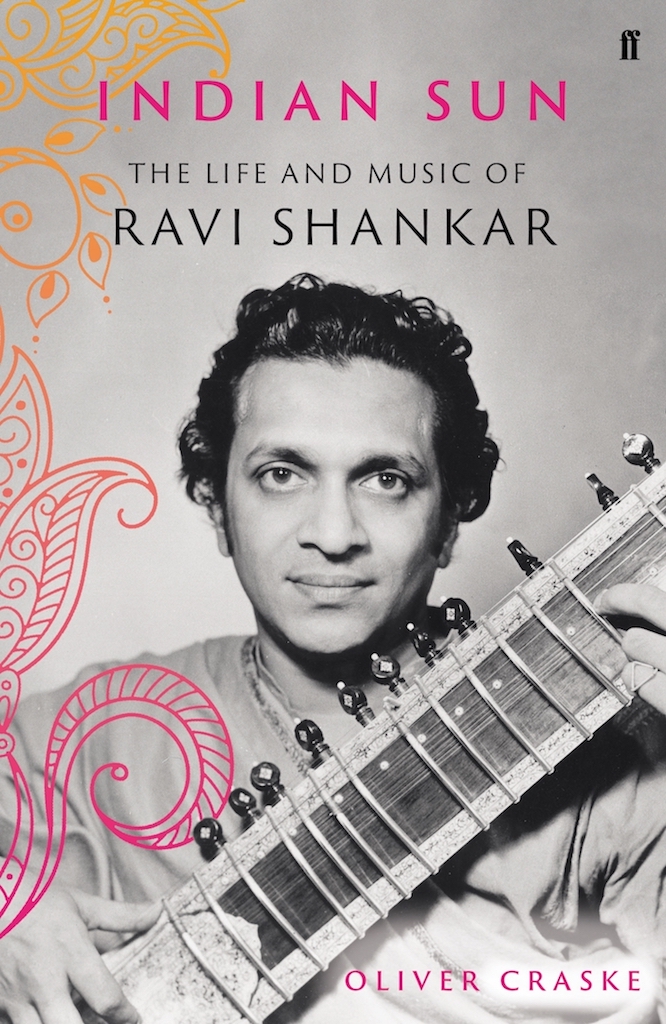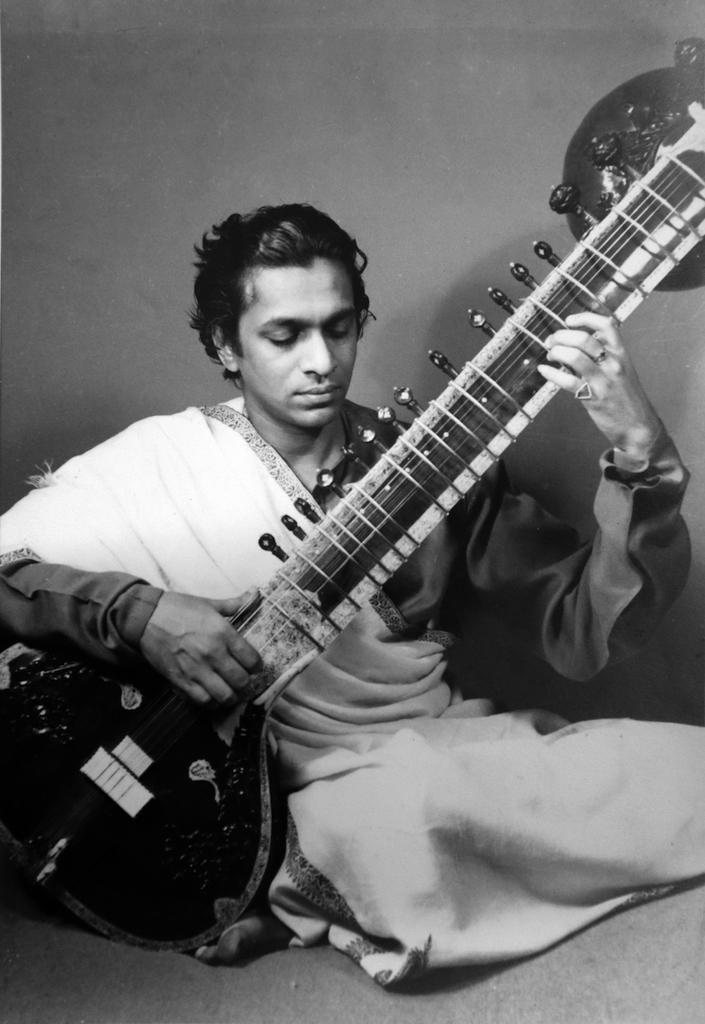Ravi Shankar was one of the giants of 20th century music. A musician, composer and teacher, he had an extraordinarily fruitful career that spanned nine decades and reached the entire world. He did more to build a bridge between the music and spirituality of India and the West than any of his contemporaries.
He is probably most widely-known known for his relationship with George Harrison and the association of the sitar with the psychedelic explorations of the 60s. There was however, a good deal more, as we discover in an outstanding, forensic and deeply sympathetic biography by Oliver Craske: the brilliantly original soundtracks for instance, he produced for Satyajit Ray and Jonathan Miller, his deep influence on America’s minimalists, not least Philip Glass, collaborations with Yehudi Menuhin and experiments with the orchestration of solo-focused Indian classical music. And most of all his revitalisation as a performer and teacher of a rich and complex musical tradition that reached back to the 16th century Mughal court and well beyond.
Craske was, in many ways, the ideal author for this first biography: he was close to India’s master musician, and collaborated with him on his vivid autobiography “Raga Mala” (1997). Craske is also a serious student of Hindustani vocals, and has an Indian wife. Writing such a penetrating portrait requires the ability to mirror Shankar’s lifelong dedication to cultural conversation, a task that is at one level impossible – as with all authentic translation. And yet, this book does a great deal to bridge the gap, and describe the challenge that Raviji (as he was known to those around him) faced in choosing to connect two very different worlds: the East, where divine presence infuses all thought and action, and the West, where a more materialistic outlook has held sway for centuries. For those not so familiar with Indian music, the author includes a number of passages in which he explains the fundamentals of the raga system and the intricate rhythmic patterns or tal, as well as the universe of microtones and the art of sliding from one tone to another that is so characteristic to music from the East in general.
Raviji often spoke of a core sadness at the heart of his being
Craske deftly traces a number of interconnected threads in Shankar’s immensely productive and frantically busy life: his conscious mission to acquaint the world with Indian music – classical and devotional, his perpetual passion for expanding the realm of his own traditions, a guilt-ridden struggle with a very complicated - yet at times joyous - personal life, and a series of long-lasting and intimate creative relationships with Western musicians, not least Yehudi Menuhin, George Harrison, and Philip Glass.
The biography stalls a little when the author takes us through year after year of tours, gigs and meetings, often without sufficient dates. There is just too much detail. Luckily, Craske is a very fluent, sober and clear writer. The book takes off when we plunge into a particular constellation of events, such as the arrival of brother Uday Shankar’s dance troupe in New York in the early 1930s, when Ravi played in the orchestra as a young child, or the celebrated Monterey Rock Festival in 1967, which brought to a climax Shankar’s emergence as a countercultural superstar, not least in the exhilarating finale to D A Pennebaker’s celebrated film of the event.
 As a trusted friend of the family, Craske has had access to the entire Shankar archive, and interviewed just about every surviving key witness to his life, excluding Sue Jones, Norah’s mother. As his widow Sukanya felt totally secure in her husband’s love and devotion, this in no way precluded a thorough exploration of every aspect of Raviji’s life, not least his abundant and very ‘free’ relationships with a great deal of women. He was a charismatic and attractive man, not just for his looks, but because he was gentle and attentive, and had the knack for making those around him feel important, without ever resorting to flattery. Although there’s a good deal that comes straight from the musician’s autobiography, Craske has gone further and delved into Shankar’s letters not least to one of his first disciples Harihar Rao, many of which give an insight that goes beyond the man’s reliance in interviews on a well-rehearsed narrative, designed to please the listener, a performance rather than a real opening onto his inner world.
As a trusted friend of the family, Craske has had access to the entire Shankar archive, and interviewed just about every surviving key witness to his life, excluding Sue Jones, Norah’s mother. As his widow Sukanya felt totally secure in her husband’s love and devotion, this in no way precluded a thorough exploration of every aspect of Raviji’s life, not least his abundant and very ‘free’ relationships with a great deal of women. He was a charismatic and attractive man, not just for his looks, but because he was gentle and attentive, and had the knack for making those around him feel important, without ever resorting to flattery. Although there’s a good deal that comes straight from the musician’s autobiography, Craske has gone further and delved into Shankar’s letters not least to one of his first disciples Harihar Rao, many of which give an insight that goes beyond the man’s reliance in interviews on a well-rehearsed narrative, designed to please the listener, a performance rather than a real opening onto his inner world.
Craske’s central theme is a psychological one: the key to Ravi Shankar’s restlessness, and butterfly-like succession of relationships with women – often several at the same time - lies, he argues, in childhood trauma: repeated rape in his native city of Varanasi (this is the biography’s central revelation) and an almost totally absent father. He had three father-substitutes – his brother the dancer and choreographer Uday, his stern but loving music teacher Allauddin Khan, and his spiritual guru Tat Baba. But he had great difficulty with his own son Shubho – born of his mostly very difficult relationship to his first wife, Annapurna, his music guru’s daughter. After Shubho’s death, Shankar found a less equivocal substitute in George Harrison, whom he unconditionally loved.
Raviji often spoke of a core sadness at the heart of his being, a void which he spent a lifetime trying to fill – with music, people and, perhaps more important, a very rich spiritual life focused on the extraordinarily powerful and apparently supernatural relationship he had with Tat Baba. Craske understands, with his heart as well as his head, the importance of a deep connection with the life of the spirit. It is perhaps this aura of spiritual aspiration that attracted people so strongly to Raviji. He lived his devotion without pretence, the spirit filled every note that he played, and this devotee’s focus made him very critical of those who sought hedonism in the drug experience, using his music as a soundtrack to trips that he felt were poor substitutes for authentic connection to the divine.
The inner yearning that drove Ravi Shankar fuelled his incomparable creativity – a torrent of work, not always of the very highest order, as Craske demonstrates. He drove himself relentlessly, until the very end, the final twenty years of his life hardly less prolific than before, with the unstinting support of his immensely devoted and well-organised wife Sukanya. There was also his delight in his very talented daughter Anoushka, matched by a less intimate but strong relationship with his other daughter, the equally gifted Norah Jones. Paradoxically, this powerhouse of creative force was deeply vulnerable, subject to frequent periods of illness from early childhood and regularly in hospital for major interventions during the last 25 years of his life. This unusual degree of openness and sensitivity plagued him, but the wounds he carried, emotionally and physically, may have enabled the flow of new ideas and passion for exploration that never ceased until the day he died.
- Indian Sun: The Life and Music of Ravi Shankar by Oliver Craske (Faber & Faber £ 20.00)
- Read more book reviews on theartsdesk















Add comment